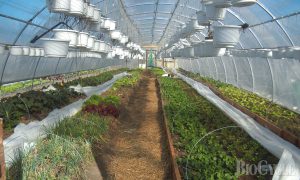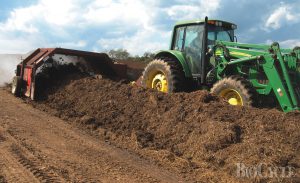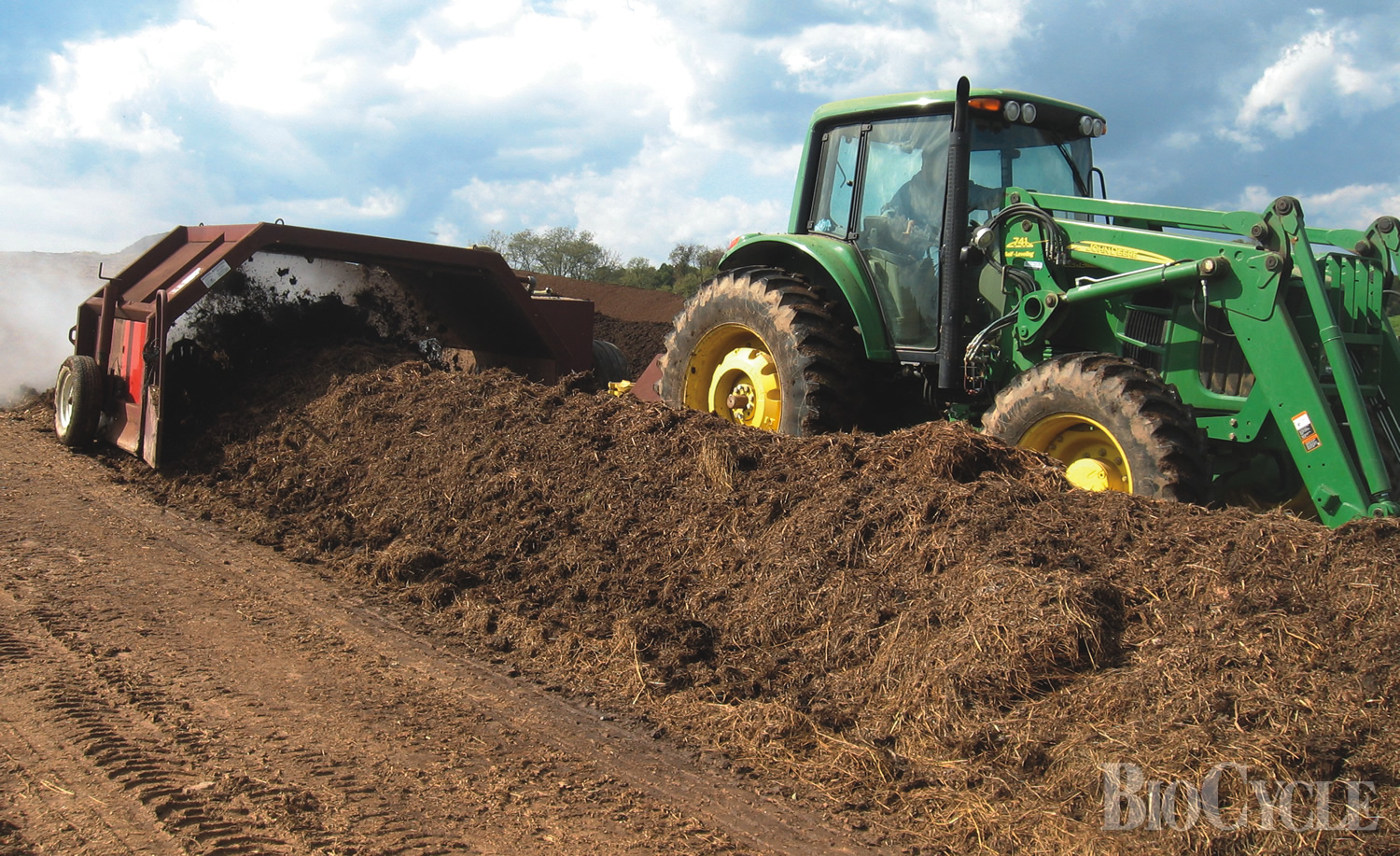Eleven states are surveyed for their noteworthy efforts and differing approaches to encourage more farms and other small-scale operators to compost, especially food scraps.
Brenda Platt, Rachel Ross, and Melody Poland
BioCycle June 2012, Vol. 53, No. 6, p. 21

Farmers have a vital role to play in producing and utilizing compost to grow crops and restore depleted soils.
Eleven states — Iowa, Maine, Massachusetts, New York, Ohio, Oregon, Pennsylvania, Rhode Island, Washington, West Virginia and Wisconsin — are surveyed here for their noteworthy efforts and differing approaches in getting more farms and other small-scale operators to compost, especially food scraps. (See Table 1 for a list of the state laws and date of passage.) It is still unclear which state policies are the most effective in boosting composting of food residuals. In addition, this is not a comprehensive analysis but focuses on the most salient composting regulations. Local policies such as those dealing with zoning can also facilitate or hamper on-farm composting.
Several states have permit exemptions for farms composting certain types of materials under a specified amount. Most states have high volume limits, or none at all when it comes to on-site generated feedstocks. New York has a 3,000 cubic yard/year (cy/yr) limit for yard debris. Pennsylvania allows farmers the option of a general permit, as an alternative to a full permit, provided they adhere to certain standards. To qualify for a general permit, the composting facility is not allowed to exceed 5 acres in size, accept more than 500 tons or 1,000 cy/yr of source separated food waste and or accept more than 3,000 cy/yr of total material (further provisions are included).
Wisconsin, among others, has no volume constraint for farm crop residue and manure when it comes to on-site farm composting. However, as the quantities of materials rise, so do the standards that facilities have to meet. Currently, Wisconsin allows up to 20,000 cy of on-site yard material and chipped wood at any one time before the requirements become more stringent.
A wide range of laws exist on acceptance of off-site (externally) generated food discards at permit-exempt composting facilities in terms of what exactly can be taken in and how much. Iowa allows no more than 2 tons/week of food residuals. For registered facilities, Rhode Island allows 1 ton/day of presorted food material but 10 tons/day of presorted vegetative material. In Ohio, operators of registered facilities are responsible for determining their own capacities and abiding by them. Table 2 includes more state examples involving food scrap thresholds.
Threshold Determination: Science or Politics?
Thresholds are a crucial component to state policies that involve exemptions for small-scale composters. High thresholds for the permit-exempt seem to increase participation in organics recycling, as it takes down the intimidating barrier of the permit process — even though some regulators argue it is not an onerous one.
Thresholds are determined in various ways. In Wisconsin, the amount “believed to be manageable at the time the composting rule was drafted” is written into the law, says Jennifer Huffman, a waste management specialist for Wisconsin’s Department of Natural Resources. Oregon uses a similar rationale: expert best guesses based on feedstock material and its potential threat to the environment. Environmental specialist Matt McDonald from Iowa’s Department of Natural Resources (IDNR) says the threshold was determined by a “rule-making process with stakeholders” and that the amount in the administrative code was the one proposed. Small-scale composting in Iowa is governed by permit-by-rule, as IDNR “wants to remove hurdles” to composting food scraps. Permit-by-rule, available to operations that pose minimal or no threat to the environment, is an alternative to the full permitting process and is often a much easier regulatory path. Currently Iowa is revising its composting regulations and may eliminate permitting based on the quantity of discarded food a facility handles.
Ohio has avoided using thresholds, but its new rules, effective April 1, 2012, allow exemptions for any type of facility under 300 square feet. This is largely “to accommodate community gardens and urban farms,” explains Angel Arroyo-Rodriguez, a composting specialist for the Ohio EPA. They can bring off-site material in and use the finished product anywhere “as long as there are no odors and air or water pollution.” Facilities over 300 square feet must register and obtain a license, which requires an annual fee based on the daily amount of tonnage handled, a plan of financial assurance and a maximum amount of materials to be indicated by the operator. Arroyo-Rodriguez likes this approach because the amount “is not an arbitrary number; they designed the facility to handle an amount of material, so we’ll hold them to that,” he says. “At any time they can make the necessary changes to accept more material. They just need to update their registration and license.”
Regardless of thresholds, states do not cite substantial problems with permit-exempt facilities abiding by the rules. In the past 13 years, Arroyo-Rodriguez cannot recall receiving complaints specific to exempted farm composting operations in Ohio. Since the exempt operations are smaller, the rare problems that do arise are containable. However, regulators unfortunately do not have hard data tracking the impact of their policies. Not all states require registration or notification of facilities qualified as exempt; thus, an accurate number of these operations and how much material is diverted from landfills because of their composting are largely unknown. States report that it would require too much staff and time to record this, as the exempt facilities are deemed low-risk. Based on the lack of recorded complaints though, it seems that all these state policies generally promote functioning small-scale composting facilities. However, it does not mean that regulators are content to keep regulations the same.
Raising the Bar
States have recognized the impacts of thresholds set too low for facilities that are wisely managed and have the ability to absorb more materials. New York is currently discussing raising their numbers from 1,000 to 5,000 cy/yr of source separated organics. According to Sally Rowland of New York State’s Division of Materials Management, there was no research to support the registration limit at the time it was decided, but “after implementing the food scrap composting registration for a number of years,” the division is “comfortable in proposing a regulatory revision to increase the registration amount.”
In Wisconsin, farms can have up to 10,000 cy of off-site generated material at one time, while small-scale composting operations can now have up to 5,000 cy of “source separated compostable material” (SSCM) at any one time under a partial exemption. According to Brad Wolbert from Wisconsin’s Department of Natural Resources, operations are partially exempt — not fully — because mandatory plans of operation must be submitted to and approved by the state.
Iowa and Oregon acknowledge that rule changes should be made in the future. While both recently passed significant revisions (in 2007 and 2009 respectively), they have identified increasing food residuals composting as a next step. In short, allowing exempt facilities to compost food scraps is on the rise.
Performance-based standards describe the environmental standards every composting facility must meet but give operators the responsibility and flexibility to design, construct and manage their operations to meet the performance standards. The three-tier system Oregon utilizes categorizes facilities by feedstock; however, the bottom-line is performance. Oregon Administrative Rule 340-096-0070(4) for example states that “All composting facilities must be designed, constructed, and operated in a manner that, to the greatest extent practicable, consistent with proper facility design and operation, controls and minimizes odors that are likely to cause adverse impacts outside the boundaries of the facility.” Such a law emphasizes the importance of performance as opposed to a more constrictive “one size fits all” method of achieving results.
Six years prior to Oregon’s revisions, Washington State adopted detailed performance-based standards in 2003. According to Chery Sullivan, Organics Specialist for the Washington State Department of Ecology, performance-based standards foster innovation and will continue to be supported through state programs like Waste 2 Resources. Ohio has followed suit; its regulation includes standards to be met without mandating how to do so. These rules foster innovation and take into account different site qualities, such as climate and soil type. Performance-based standards thereby acknowledge no one model is the best option for every facility.
Helping Farmers
States can also support small-scale farmers in their composting endeavors through two other approaches: technical assistance and rules that allow for the sale of finished compost. Technical assistance is available through compost schools that provide certification (Maine Compost School), on-site help from inspectors (Iowa’s Department of Natural Resources), and grants for innovative projects (funded by Oregon Department of Environmental Quality’s fee on every ton of waste disposed in landfills). These types of programs encourage newcomers to begin composting and give them the necessary tools to compost successfully.

States have recognized the impacts of thresholds set too low for facilities that are wisely managed and have the ability to absorb more materials.
The opportunity to sell compost provides farmers with additional revenue, as compost is a value-added farm product. Many states have detailed guidelines. Massachusetts devised three categories of compost based on quality, for instance the concentration of heavy metals. The type of compost dictates where the compost can be used and sold. Pennsylvania allows substantial flexibility. Operators with the general permit can sell compost without restriction, provided that specific standards that ensure a safe product are met. Licensed facilities in Wisconsin are also free to sell all of their compost.
The West Virginia Case
West Virginia addresses on-farm composting in a novel way: it categorizes acceptable feedstock types more broadly than most states. Passed in 2001, Title 33, Series 3 of the Department of Environmental Protection’s Division of Waste Management describes the state’s composting procedure. The rule exempts on-farm composting facilities that are less than five acres in area and handle less than 12,000 tons annually as long as they adhere to location and operational standards outlined in the Yard Trimmings Composting Regulations. The rule specifically addresses yard trimmings, however includes “other acceptable compostable materials which have been approved in writing […] to produce a safe product for use as soil amendment/soil conditioner.” Permitted materials include off-site generated preconsumer and postconsumer food scraps as well as fish and poultry carcasses, poultry litter and animal manures, according to Steve Miller, Assistant Commissioner of the West Virginia Department of Agriculture. He states that the department is working on specifying livestock and wildlife carcasses as acceptable materials. West Virginia’s code also lets farmers sell their compost without restriction, but if they charge customers to accept food residuals then they must obtain permitting as commercial yard trimmings composting facilities. This does not apply if farmers ask for a “composting fee” to cover operational costs such as collecting materials and turning rows.
Future Steps
Compost regulations regarding small-scale operators are fortunately far from being stagnant. State regulators recognize the importance of evaluating the impacts of their codes and taking note of points to improve. The current rise of food discards, pre and postconsumer, handled by exempt facilities is one result of regulation revisions. Ohio’s performance-based approach will facilitate composting at the small-scale, local level where it can bring benefits to the community by allowing materials to be collected and used without requiring cost-prohibitive financial assurance. Wisconsin’s rules are being revised to include food scraps and West Virginia is expanding the reach of exempted materials allowed as well.
States like Washington are also exploring new technologies. “It’s about matching infrastructure with opportunity,” says Chery Sullivan, adding that “some feedstocks are better suited for certain technologies.” This is why Washington has invested in developing anaerobic digestion as a key element of the organic management infrastructure. Washington’s revised solid waste rule is on schedule to be effective at the end of this year. It includes exemptions that reflect the state’s commitment to more efficient composting options, and a new section addressing solid waste permitting for anaerobic digesters.
When it comes to composting, it is essential to minimize environmental impacts to land, air and water while diverting valuable feedstocks from landfills and incinerators. However, in order to grow composting capacity, prescriptive measures may be too narrow and restricting. This is further complicated by factors such as physiographical variation, localized environmental concerns and the size of individual operations. “Maybe the approach should be to require larger buffer zones (i.e., 500 feet setbacks from any residence not owned by landowner) and to use permit conditions to limit nuisance conditions (noise, odor, vectors, hours, of operation, etc.),” says Craig Coker of Coker Composting and Consulting. His recommended strategy emphasizes prevention of risks via performance rather than limiting materials handled. This method aligns with what some states are already doing in terms of shifting more attention to performance standards rather than strict thresholds.
Brenda Platt is the Co-Director of the Washington, DC-based Institute for Local Self-Reliance (ILSR) and heads up its Composting Makes $en$e Project. Rachel Ross and Melody Poland are former ILSR interns. Current intern Bobby Bell contributed to this article.










